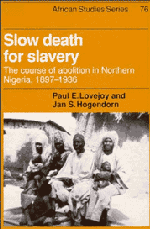Book contents
- Frontmatter
- Contents
- List of maps
- List of tables
- Preface
- 1 Slavery and the British conquest of Northern Nigeria
- 2 Fugitive slaves and the crisis in slavery policy
- 3 The debate on legal-status abolition
- 4 Emancipation and the law
- 5 Upholding proprietary rights to land
- 6 The role of taxation in the reform of slavery
- 7 The colonial economy and the slaves
- 8 The persistence of concubinage
- 9 Legal-status abolition: the final phase
- Appendix: Court records of slaves issued certificates of freedom
- Notes
- Glossary
- Bibliography
- Index
- Title in the series
1 - Slavery and the British conquest of Northern Nigeria
Published online by Cambridge University Press: 03 May 2011
- Frontmatter
- Contents
- List of maps
- List of tables
- Preface
- 1 Slavery and the British conquest of Northern Nigeria
- 2 Fugitive slaves and the crisis in slavery policy
- 3 The debate on legal-status abolition
- 4 Emancipation and the law
- 5 Upholding proprietary rights to land
- 6 The role of taxation in the reform of slavery
- 7 The colonial economy and the slaves
- 8 The persistence of concubinage
- 9 Legal-status abolition: the final phase
- Appendix: Court records of slaves issued certificates of freedom
- Notes
- Glossary
- Bibliography
- Index
- Title in the series
Summary
At the time of the colonial conquest (1897–1903), the Sokoto Caliphate had a huge slave population, certainly in excess of 1 million and perhaps more than 2.5 million people. This slave population had arisen in the course of the nineteenth century, during which the area stretching from modern Burkina Faso in the west, through Niger and northern Nigeria as far east as Cameroun was consolidated into the thirty emirates and numerous sub-emirates that comprised this large, Muslim state. The Caliphate itself was responsible for the enslavement of the servile population through war, slave raiding, and the demand for tribute from subjugated communities. As the colonial conquest began, slavery was very much a functioning institution. People were still being enslaved, and the trade in slaves was of considerable proportions. It is no wonder, then, that slavery figured prominently in the conquest itself.
It is now widely recognized that slavery was common in many parts of the world well into the modern era, not only in the Americas but also throughout the Islamic world and in China, India, and southeast Asia. The Ottoman Empire certainly had a large slave population, and many of its slaves came from sub-Saharan Africa, including the Sokoto Caliphate. Recent scholarship has tended to treat slavery as a world-wide phenomenon, with significant sub-divisions that can be identified with classical antiquity, medieval Europe, Islam, the non-Muslim areas of Asia, and Africa.
- Type
- Chapter
- Information
- Slow Death for SlaveryThe Course of Abolition in Northern Nigeria 1897–1936, pp. 1 - 30Publisher: Cambridge University PressPrint publication year: 1993

